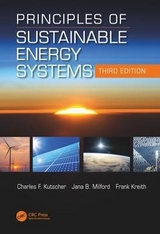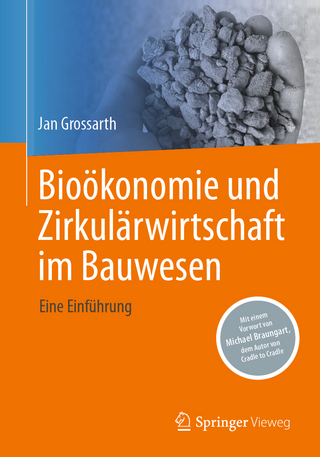
Principles of Sustainable Energy Systems
Crc Press Inc (Verlag)
978-1-4665-5696-6 (ISBN)
- Titel erscheint in neuer Auflage
- Artikel merken
The book provides complete and up-to-date coverage of all renewable technologies, including solar and wind power, biological processes such as anaerobic digestion and geothermal energy. The new edition also examines social issues such as food, water, population, global warming, and public policies of engineering concern. It discusses energy transition—the process by which renewable energy forms can effectively be introduced into existing energy systems to replace fossil fuels.
See What’s New in the Second Edition:
Extended treatment of the energy and social issues related to sustainable energy
Analytic models of all energy systems in the current and future economy
Thoroughly updated chapters on biomass, wind, transportation, and all types of solar power
Treatment of energy return on energy invested (EROI) as a tool for understanding the sustainability of different types of resource conversion and efficiency projects
Introduction of the System Advisor Model (SAM) software program, available from National Renewable Energy Lab (NREL), with examples and homework problems
Coverage of current issues in transition engineering providing analytic tools that can reduce the risk of unsustainable fossil resource use
Updates to all chapters on renewable energy technology engineering, in particular the chapters dealing with transportation, passive design, energy storage, ocean energy, and bioconversion
Written by Frank Kreith and Susan Krumdieck, this updated version of a successful textbook takes a balanced approach that looks not only at sustainable energy sources, but also provides examples of energy storage, industrial process heat, and modern transportation. The authors take an analytical systems approach to energy engineering, rather than the more general and descriptive approach usually found in textbooks on this topic.
Introduction to Sustainable Energy
Sustainability Principles
Carrying Capacity
Context for Sustainable Energy
Key Sustainability Considerations
Energy Efficiency and Conservation
Energy from Fossil Fuels
Nuclear Energy
Renewable Energy
Hydrogen
NREL System Advisor Model
Energy Units and Conversion Factors
Problems
Discussion Questions
Online Resources
References
Suggested Readings
Economics of Energy Generation and Conservation Systems
Unit Cost of Energy
Payback Period
Time Value of Money
Inflation
Societal and Environmental Costs
Total Life Cycle Costs
Internal Rate of Return
Capital Recovery Factor
Levelized Cost of Energy
Input–Output Analysis
Energy System Analysis Methodologies
Energy Return on Energy Invested
EROI for a Wind Energy System
EROI for Nuclear Power
Relation between Energy Return on Energy Invested and Monetary Return on Investment
Problems
References
Wind Energy, Contributing Author: Gary E. Pawlas
Wind Power in a Nutshell
Power and Energy
Fact or Fiction: Common Questions about Wind Turbines
History of Wind Turbine Development: HAWTs and VAWTs
Introduction to Wind Turbine Performance
Aerodynamics
Wind Characteristics
Turbine Performance
Cost of Energy
Wind Farms
Offshore Wind Energy
System Advisory Model
Additional Topics for Study
Acknowledgment
Problems
References
Capturing Solar Energy through Biomass, Contributing Authors: Robert C. Brown and Mark M. Wright
Biomass Production and Land Use
Waste Material
Energy Crops
Algae
Land Use for Biomass Production
Important Properties of Biomass
Biomass Process Economics and Technology
Conversion of Biomass to Gaseous Fuels
Conversion of Biomass to Liquid Fuels
Conversion of Biomass to Electricity
Fossil and Biomass Fuel Properties
Conclusions
Problems
References
Fundamentals of Solar Radiation
Physics of the Sun and Its Energy Transport
Thermal Radiation Fundamentals
Sun–Earth Geometric Relationship
Solar Radiation
Estimation of Terrestrial Solar Radiation
Models Based on Long-Term Measured Horizontal Solar Radiation
Measurement of Solar Radiation
Problems
References
Photovoltaics
Semiconductors
Analysis of Photovoltaic Cells
Manufacture of Solar Cells and Panels
Design for Remote Photovoltaic Applications
Thin-Film PV Technology
Multilayer PV Technology
PVWatts for PV Performance Estimates
Problems
References
Suggested Readings
Solar Heating and Cooling of Buildings
Radiative Properties and Characteristics of Materials
Flat-Plate Collectors
Evacuated Tube Collectors
Experimental Testing of Collectors
Calculations of Heating and Hot Water Loads in Buildings
Solar Water-Heating Systems
Liquid-Based Solar Heating Systems for Buildings
Methods of Modeling and Design of Solar Heating Systems
Solar Cooling
Solar Desiccant Dehumidification
Problems
References
Solar Process Heat and Thermal Power
Historical Perspective
Solar Industrial Process Heat
Parabolic Collectors
Long-Term Performance of SIPH Systems
Thermal Power Fundamentals
Solar Thermal Power Plants
Parabolic Dish Systems and Stirling Engines
Problems
References
Passive Solar Heating, Cooling, and Daylighting, Contributing Author: Jeffrey H. Morehouse
Introduction
Key Elements of Economic Consideration
Solar Thermosyphon Water Heating
Passive Solar Heating Design Fundamentals
Passive Design Approaches
Passive Space-Cooling Design Fundamentals
Daylighting Design Fundamentals
Problems
Defining Terms
References
Suggested Readings
Further Information
Energy Storage
Overview of Storage Technology
Mechanical Technologies
Direct Electrical Technologies
Fundamentals of Batteries and Fuel Cells
Rechargeable Batteries
Fuel Cells and Hydrogen
Thermal Energy Storage
Virtual Storage in the Electric Transmission Grid
Problems
References
Battery Resources
Ocean Energy Conversion
Ocean Thermal Energy Conversion
Tidal Energy
Ocean Wave Energy
Problems
References
Transportation
Introduction
Alternative Fuels
Well-to-Wheel Analysis
Mass Transportation
Hybrid Electric Vehicles
Plug-In Hybrid Electric Vehicles
Advanced Ground Transportation with Biomass Fuel
Future All-Electric System
Hydrogen for Transportation
Natural Gas as a Transitional Bridging Fuel
Problems
Energy Committee
References
Online Resources
Transition Engineering, Contributing Author: Susan Krumdieck
Foundations of Transition Engineering
Anthropogenic System Dynamics
Risk Management
Framework of Change Projects
Strategic Analysis of Complex Systems
Concluding Remarks
Problems
References
Index
| Reihe/Serie | Mechanical and Aerospace Engineering Series |
|---|---|
| Zusatzinfo | 12 page color insert follows pg 390; 644-700 equations; 148 Tables, black and white; 23 Illustrations, color; 396 Illustrations, black and white |
| Verlagsort | Bosa Roca |
| Sprache | englisch |
| Maße | 178 x 254 mm |
| Gewicht | 1542 g |
| Themenwelt | Mathematik / Informatik ► Mathematik |
| Naturwissenschaften ► Biologie ► Ökologie / Naturschutz | |
| Technik ► Elektrotechnik / Energietechnik | |
| ISBN-10 | 1-4665-5696-X / 146655696X |
| ISBN-13 | 978-1-4665-5696-6 / 9781466556966 |
| Zustand | Neuware |
| Haben Sie eine Frage zum Produkt? |
aus dem Bereich



